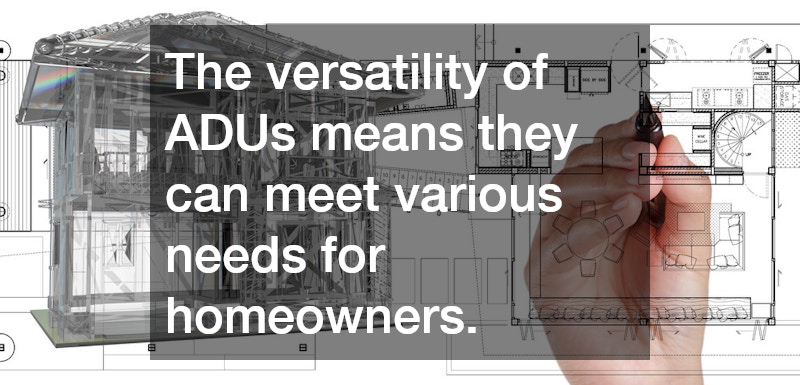The trend of building Accessory Dwelling Units (ADUs) has been on the rise. Whether you’re aiming to generate additional income, provide housing for your family, or add property value, understanding the essentials before you start the journey is crucial. This article provides five must-have insights to help guide your project from conception to completion. For expert advice and support, reach out to Pacgen Construction, your trusted ADU builders in Temecula, CA!
What Is an ADU and Why Build One?
Defining ADUs
Accessory Dwelling Units (ADUs) are secondary housing units on a single-family residential lot. Known also as granny flats, in-law units, or backyard cottages, ADUs come in various forms including detached, attached, and garage conversions.
Understanding the core concept of an ADU involves recognizing its distinct nature as an independent living space complete with its own kitchen, bathroom, and entrance.
Types of ADUs vary greatly depending on local regulations and homeowner preferences. Detached ADUs are separate buildings, offering the utmost privacy and flexibility. Attached ADUs maintain some connectivity with the main house but provide an independent living area. Converting existing spaces, such as attics or basements, into internal ADUs is another popular option, allowing homeowners to utilize underused space.
The versatility of ADUs means they can meet various needs for homeowners. Whether the purpose is housing family members, particularly aging parents, or creating a dedicated rental unit to generate income, the defining aspects of ADUs provide significant opportunities for enhancing living space and optimizing property use.
Benefits of ADUs
Building an ADU comes with a multitude of benefits that can significantly enhance the homeowner’s financial and living situation. One of the primary advantages is the potential increase in property value. As real estate trends continue to favor multi-functional living spaces, properties with ADUs often see a higher market valuation, appealing to buyers looking for flexible housing options.
ADUs offer a practical solution for multigenerational living arrangements. Many families face the challenge of providing care and support for elderly parents or young adult children. An ADU offers the ideal compromise, providing proximity while maintaining independence for all parties involved. This flexibility in living arrangements can relieve stress and improve family dynamics.
Another compelling reason to build an ADU is the opportunity to generate rental income. With housing shortages prevalent in many urban areas, rental markets are thriving. Renting out an ADU can provide a steady stream of additional income, helping homeowners manage mortgage payments or other financial obligations. This economic benefit, coupled with the enhanced property appeal, makes ADUs a sound investment choice.
How to Navigate Zoning and Permitting Regulations
Understanding Zoning Laws
Zoning laws are pivotal to the feasibility of constructing an ADU. These regulations, which vary significantly by city and county, dictate where ADUs can be built and impose limits on their size and density. Homeowners must start by acquainting themselves with local zoning ordinances to ensure their project is compliant.
Many municipalities have adopted more flexible zoning regulations to encourage the development of ADUs as a means to combat housing shortages. As part of this effort, some areas have reduced restrictions on lot size and setbacks, making it more feasible for homeowners to build. However, understanding specific requirements such as maximum allowable square footage and height is crucial to avoid costly redesigns.
Consulting with local planning departments or engaging a zoning professional can help clarify these often complex regulations. Taking these steps early in the planning process helps prevent surprises and aligns the project with community standards. Ultimately, thorough research into zoning laws lays the foundation for a successful ADU project.
The Permitting Process
Navigating the permitting process is a crucial step in building an ADU. The process typically requires a series of permits, including building, electrical, plumbing, and sometimes special-use permits, depending on local requirements. Each permit comes with its guidelines and fees, which can impact both the timeline and budget of the project.
Obtaining these permits involves submitting detailed plans to the local building authority for approval. Plans must adhere to building codes and demonstrate compliance with zoning laws. Homeowners should prepare for potential revisions, as reviewers may request changes to meet safety and public welfare standards.
While the permitting process may seem daunting, thorough preparation and understanding can prevent unnecessary delays. Hiring experienced professionals, such as architects and contractors familiar with local laws, can streamline this process. Their expertise ensures that submissions meet regulatory standards, facilitating quicker approvals and setting the stage for a smooth construction phase.
What are the Costs and Financing Options for Building an ADU?
Estimating the Costs
The financial aspect of building an ADU is a significant consideration. Costs can vary widely based on the size, design, materials, and labor required for the project. On average, the cost to build an ADU can range from $100,000 to over $300,000, depending on location and specific project details.
Construction costs form the bulk of this expenditure and include site preparation, foundation work, and the building structure. Labor costs are also a major component, influenced by regional labor rates and the complexity of the work. Additionally, material costs, which can fluctuate based on market conditions and selection quality, should be carefully evaluated.
To manage these expenses effectively, homeowners should develop a detailed budget accounting for all potential costs and contingencies. Engaging a contractor early in the planning stage can provide more accurate estimates, helping refine the financial plan and ensuring the project remains economically viable.
Financing Your ADU
Once costs are estimated, securing financing is the next critical step. There are several financing options available for building an ADU, each with its pros and cons. Homeowners may consider home equity loans or lines of credit, which leverage the existing home’s value to secure funds with relatively low-interest rates.
Many regions offer specific loan programs designed to promote ADU development as part of affordable housing initiatives. These programs may offer favorable terms and flexible repayment options, alleviating some of the financial burdens. Additionally, certain government grants may be available to assist in the construction costs of ADUs aimed at affordable or low-income housing.
Tax incentives, such as deductions for interest on loans used to finance an ADU, can also play a role in funding the project. Exploring all available financial avenues, including traditional mortgages and personal loans, helps ensure the project is not only affordable but strategically planned for long-term financial health.
Conclusion
Building an ADU is a significant investment that requires careful planning and consideration. By understanding the foundational elements, aligning with legal regulations, and planning your finances effectively, you can ensure a successful and rewarding project. These insights are your first step towards transforming your property with a well-designed ADU.

